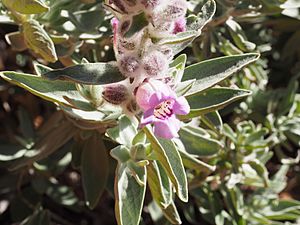Pityrodia facts for kids
Quick facts for kids Pityrodia |
|
|---|---|
 |
|
| Pityrodia augustensis | |
| Scientific classification |
|
| Kingdom: | Plantae |
| Clade: | Tracheophytes |
| Clade: | Angiosperms |
| Clade: | Eudicots |
| Clade: | Asterids |
| Order: | Lamiales |
| Family: | Lamiaceae |
| Subfamily: | Prostantheroideae |
| Genus: | Pityrodia R.Br. |
| Species | |
|
See text |
|
| Synonyms | |
|
|
Pityrodia is a group of flowering plants. They belong to the mint family, which is called Lamiaceae. These plants are only found in Australia. Most of them grow in Western Australia. A few are found in the Northern Territory and one species grows in Queensland. Pityrodia plants are shrubs. Their flowers have five petals that join together to form a tube shape. Each flower also has four stamens, which are parts that produce pollen. These stamens are not all the same length.
Contents
What Pityrodia Plants Look Like
Pityrodia plants are evergreen shrubs. This means they keep their leaves all year round. Their branches usually stand upright and are shaped like cylinders. The leaves are simple, meaning they are not divided into smaller leaflets. You can see a network of veins on them. The base of each leaf partly wraps around the stem.
The flowers can grow alone or in small groups. They have a special kind of balance called left-right symmetry. This means if you cut the flower down the middle, both halves would look the same. Each flower has five sepals, which are like small leaves that protect the bud. These sepals are joined at their bases. There are also five petals that are joined together to form a tube.
The tip of this flower tube can have five unevenly sized parts, like small flaps. Or, it might have two "lips." The upper lip has two parts, and the lower lip has three. Inside the flower, there are four stamens. One pair of stamens is longer than the other pair. After the flower blooms, it produces a fruit called a drupe. This fruit is like a small plum or cherry and can hold up to four seeds inside.
How Pityrodia Got Its Name
The group of plants known as Pityrodia was first described in 1810. This was done by a botanist named Robert Brown. He wrote about it in his book called Prodromus Florae Novae Hollandiae. Brown also chose Pityrodia salvifolia as the main example for the group.
The name Pityrodia comes from an Ancient Greek word. It means "scale-like."
At first, Pityrodia was placed in a different plant family called Verbenaceae. Later, in 1979, a scientist named Ahmad Abid Munir studied the genus. He suggested putting Pityrodia and nine other groups of plants into a new family called Chloanthaceae. These plants were all found only in Australia. However, the name Chloanthaceae was not widely used. Today, Pityrodia is part of the Lamiaceae family, which is the mint family.
Where Pityrodia Plants Grow
In 1979, Ahmad Munir identified 27 species of Pityrodia in Western Australia. He also found 16 species in the Northern Territory and one in Queensland.
However, in 2011, other scientists like Barry Conn, Murray Henwood, and Nicola Streiber made some changes. They moved some of the Pityrodia species to other plant groups. These new groups include Dasymalla, Hemiphora, and Quoya. They also created a brand new group called Muniria, and four former Pityrodia species were moved there.
Since then, a new species from Western Australia has been discovered. It is called Pityrodia iphthima.
Here are the species that are still part of the Pityrodia group:
- Pityrodia augustensis Munir - Mt. Augustus foxglove (W.A.)
- Pityrodia byrnesii Munir (N.T.)
- Pityrodia canaliculata A.S.George (W.A.)
- Pityrodia chrysocalyx (F.Muell.) C.A.Gardner (W.A.)
- Pityrodia gilruthiana Munir (N.T.)
- Pityrodia hemigenioides (F.Muell.) Benth. (W.A.)
- Pityrodia iphthima K.A.Sheph. (W.A.)
- Pityrodia jamesii Specht (N.T.)
- Pityrodia lanuginosa Munir (N.T.)
- Pityrodia lepidota (F.Muell.) E.Pritz. (W.A.)
- Pityrodia loricata (F.Muell.) E.Pritz. (W.A., N.T., S.A.)
- Pityrodia obliqua W.Fitzg. (W.A.)
- Pityrodia puberula Munir (N.T.)
- Pityrodia pungens Munir (N.T.)
- Pityrodia salvifolia R.Br. (Qld.)
- Pityrodia scabra A.S.George (W.A.)
- Pityrodia serrata Munir (N.T.)
- Pityrodia spenceri Munir (N.T.)
- Pityrodia ternifolia (F.Muell.) Munir - Golden bush (W.A., N.T.)
- Pityrodia viscida W.Fitzg. (W.A.)
See also
 In Spanish: Pityrodia para niños
In Spanish: Pityrodia para niños

